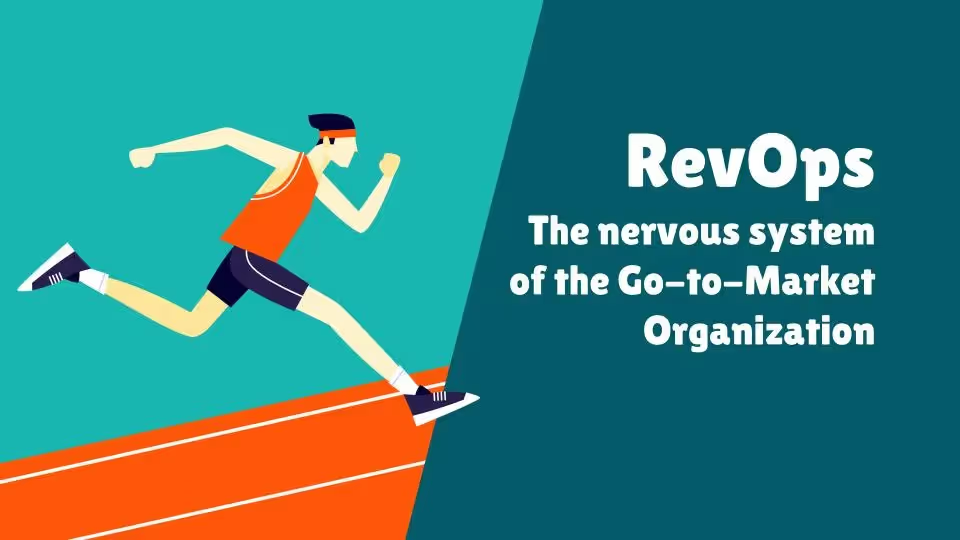Revenue operations (RevOps) aligns sales, marketing, and customer success to drive unified go-to-market (GTM) performance and maximize revenue growth.
- Bridge gaps between finance, reporting, and operations for seamless GTM execution.
- Break down silos by integrating data, tools, and processes across teams.
- Enable strategic, data-driven decisions for faster business impact.
- Adopt RevOps when challenges span multiple functions, not just isolated departments.
As of March 2021, there are about 21,000 people on LinkedIn with a mention of Revenue Operations (Revops) on their job titles. That’s a significant jump for a role that was almost non-existent five years back. Don’t worry. There was no University specialization course that you missed. The people who are part of Revops didn’t come out of colleges but rather from an evolution of 3 critical functions in GTM - Finance, Reporting, and Operations.
So, What is Revenue Operations?
The Revops team is the central team that orchestrates the entire GTM organization by constantly monitoring and making adjustments, as necessary, to deliver top-notch results.

The rise of Revops has been dramatic. Over the last two decades, companies have understood the importance of sales operations and marketing operations. Of late, customer success operations have also come into the mix. The importance of having a singular view across all GTM organizations has risen in the last five years.
And the main reason is due to the rise of recurring revenue business models. It is tough to draw clear boundaries when marketing ends when sales start, and when sales end and customer success begins. And, the continued focus on delivering consistent topline growth has given rise to Revenue operations.
In practice, according to a study, ‘Public companies with revenue ops also had 71% higher stock performance’.
If the above things are causated, it pays to think about two things here.
- What will the Revenue Operations function bring to the table, which I am not doing today?
- When should I think about setting up a Revenue Operations team?
Let us jump into these two questions.
What Does Revenue Operations Bring to the Table?
.avif)
Establish Clear Goals for Your Go-to-Market (GTM) Organization
It all starts with establishing the goals of the GTM organization. Organizations can have different needs depending on the market, targeted customer base, and even growth phase. The purpose of Revenue Operations is to orchestrate the GTM pieces to fulfill those goals.
Revenue Operations can by themselves have multiple goals to translate the core GTM goal. For, e.g., the GTM goal to achieve 60% YoY growth on Revenue can translate into plans for Revops as:
- Improving customer retention by 30%
- Improving conversion rates by 50%
- Growing top-of-the-funnel by 2x in a specific geography/vertical
- Reduction in the sales cycle by 20%
You get the drift. Prioritize your needs and ensure that each GTM function has only one primary goal. A dilution of focus has been the pitfall of many initiatives.
Find Process Gaps Preventing You from Achieving Goals
With clear objectives in place, the next step is to assess what stops the organization from achieving them. The challenges could be having inconsistent/inadequate data, misaligned incentives for teams, or an inability to identify growth opportunities.
A typical example is Marketing and Sales leaders always being at loggerheads about the pipeline generated. This happens when the lead qualification process is not well defined, and there are no measures set up to evaluate lead quality. This gap can create imbalances when it comes to incentive alignment for the teams, and ultimately the GTM organization suffers.
Identify Challenges and Create a Charter to Solve them
Once you establish the goals, the next step is to find out the challenges that will stop you from solving them. Usually, you could bucket the challenges into four categories.
.avif)
Org Structure
Deploying dedicated teams to tackle problems can be a good thing. In reality, this ends up creating silos within the business. These hamper information flow and make it harder to execute initiatives that cut across functional boundaries. Prioritize these challenges as they can have detrimental effects on any new initiatives.
Operational
A business, like a car, has many moving parts, and if they do not operate at the same rhythm, the outcome can range from having a bumpy ride to complete failure. Business processes help set the coordination between these parts. These processes can become overwhelmed by changes or volume if not designed well.
E.g., A leading routing process failing to manage surges in volume causes delays in sales leads. Hot inbound leads not being acted upon quickly will make a big dent in your conversion rates and certainly lead to revenue loss.
Tools/Tech Stack
This is a common one for most organizations. It arises when the current Tech stack is not capable of executing tasks efficiently. Many organizations see this with their CRMs, where teams often complain how they are losing valuable time trying to find basic information.
Insight Generation
With the availability of more accessible data storage, most organizations have become good at collecting data. However, the data is not truly useful unless it is available to be processed to generate helpful information or insight. Without this, often, it becomes challenging to make critical decisions.
Assess Overlap in Terms of Business Functions
Once you have done the previous steps, it's time to step back for a moment.
It means asking questions like - is their impact limited to respective functions, or are they able to impact multiple groups as we move down the line? For example, inaccurate lead enrichment may seem like a challenge only for marketing. These same leads, which become customers later, will create issues for your customer success and support teams.
Should You Set Up a Revenue Operations Team Today?
Once the challenges are characterized and their breadth established, it is now time to assess whether you need to set up the Revops team. Gauge whether the obstacles stopping you from achieving your goals need to be tackled from multiple fronts or localized to specific functions. A revops team can deliver the most value if the problems require coordination between various teams to solve.
Revops consists of multiple roles, with a leader orchestrating the whole thing. But the Revops team can be built module by module as and when the needs arise. The section below describes these essential parts and suggestions on when they can be implemented.
Different Modules of a RevOps Team and When to Implement Them
.avif)
- Tools/Tech Stack module: Work associated with this module starts when the GTM organization sets up a proper CRM. Ideally, a place where all your sales and marketing processes reside. I emphasize the term ‘Ideally’ because anyone who has managed a CRM will know things are never Ideal. These problems get exasperated further when multiple systems like marketing automation, subscription management, and even customer support start linking together. To ensure the result is not a tangled mess of information, it is vital to focus on this from the start.
- Insights/reporting module: Imagine you have your shiny new system up and running, generating precious data. The next step is to mold that raw information into processed bite-size pieces of Insight. In contrast, basic reporting is a standard functionality built into most CRMs. Interested people with contextual understanding can only extract the actual value of data. It is a repetitive cycle of formulating and testing multiple hypotheses to arrive at actionable Insights. The impact of these can be profound on business as they can shape both strategy and execution.
- Process module: All Organizations operate with a set of processes and activities which help them run efficiently. These may be for transactional tasks such as managing contracts, Approvals, etc. but could also apply to analytical activities such as forecasting and compensation management. It is typical for this to be one of the first teams to be set up within the operations umbrella. The most common trigger for such a team to be set up is when the GTM organization reaches about ten people.
- Policy module: As soon as you start carving out quota plans and territories, an uninvited guest will appear - ‘Conflict’ The only way to manage these in a fast-growing company is to have a robust policy framework. The document needs to be a living policy document that is constantly evolving for new scenarios. Dedicated resources are required to establish and maintain the framework. They are also responsible for addressing all issues raised by teams and ensuring the playing field is level for everyone. Organizations will start seeing challenges in these areas when expanding to new geographies or start splitting existing territories to go deeper.
- Enablement module: The operations team can identify opportunities for better execution in the sales process through insights that they generate. However, beyond a specific organization size, that is not enough. In the growth phase, teams need a robust framework to continuously train new and existing members to bolster talent and capitalize on its momentum. The enablement group can focus on these aspects and create a curriculum of focused training. They also provide a repository of materials like email templates, presentations, case studies, etc. A good benchmark to start investing resources into this module is when the Sales team hit a size of 20.
Why Should I Combine These Functions Under RevOps?
Some of these functions like tools and tech stack, insights, and analytics might already exist as part of your organization today. So, you might be thinking about why I should build Revops when I can get the same job done by separate teams.
Revops is built for agility and moving fast according to the needs of GTM, and hence it is vital to bring these functions under one umbrella. You can’t expect your tools and tech stack for GTM teams to be managed by IT teams whose goals are more towards cost-saving and business continuity.
GTM goals will be more towards hitting revenue goals as efficiently as possible, which means that we need to take risks and try out new processes and tools all the time to get more revenue. These goals can never be fully translated into a good charter by a tech-savvy IT team.
The same goes for data analytics. Advanced analytics is not helpful if someone doesn’t understand the challenges that prevent a sales team from operating at their best. So, having these teams in silos might work for you today, but you will slow your growth down the line if you are not unifying these functions under one umbrella.
Investing in Revops is a must for all businesses, though the pace and quantum can change based on their particular needs. State of Revenue Operations 2019 study showed a 55% increase in Revenue operation adoption, and I share the optimism of the 2400+ participants of the study.
While this article aims to outline a framework for establishing what RevOps does and when to hire for RevOps, I would request founders and leaders to be a little lenient with the guidelines given.
The worst decision here is not to act. Setting up the Revops team can mean the difference of a runner (GTM organization) having an explosive boost right off the starting blocks, which carries them off to the win (revenue goals) versus a false start leading to decisive failure.
If you're a RevOps pro, you'd love to see what we've built at Everstage (We're a group of RevOps professionals as well). Book a demo to know how our automation platform can help you with tracking commissions, managing quotas and more.


%25402x.avif)









